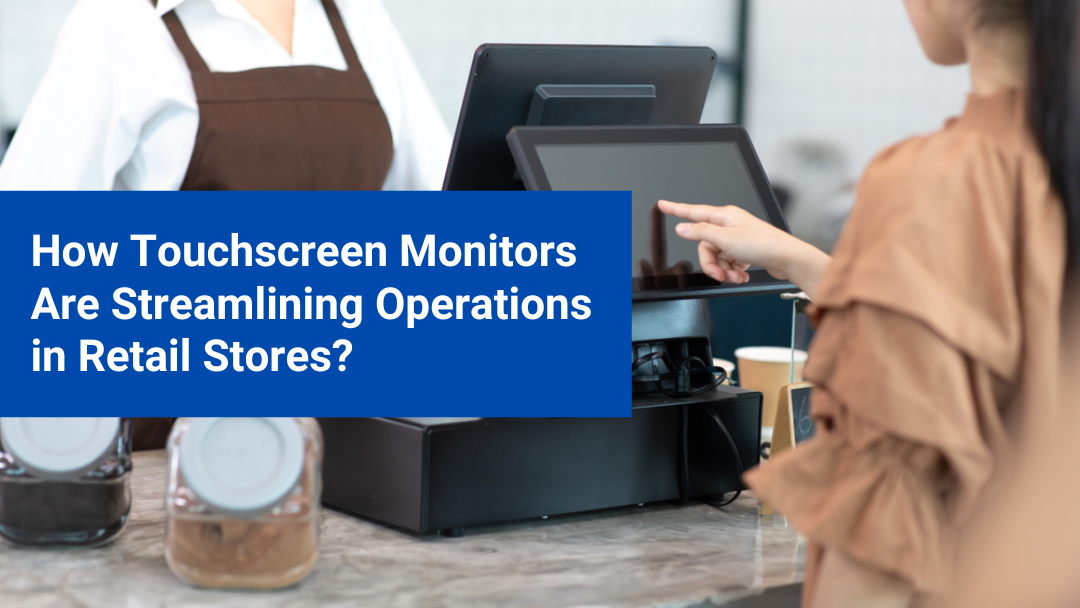How Touchscreen Monitors Are Streamlining Operations in Retail Stores?
Benefits of touchscreen monitors in retail stores:
Touchscreen monitors are significantly enhancing the efficiency of retail operations by providing intuitive and versatile tools that streamline various processes. Here’s how they are making a difference:
1) Enhanced Customer Interaction:
- Interactive Product Displays: Touchscreen monitors enable customers to browse product catalogs, view detailed information, and explore options such as sizes, colors, and reviews with just a few taps. This self-service capability reduces the need for intervention from sales staff.
- Self-Service Kiosks: These kiosks allow customers to place orders, customize products, and complete purchases independently, speeding up the shopping process and reducing wait times.
2) Streamlined Checkout Process:
- Faster Transactions: Touchscreen POS systems are user-friendly and reduce transaction times. Their intuitive interfaces minimize errors and speed up payment processing, leading to shorter lines and a better customer experience.
- Mobile POS Solutions: With the integration of touchscreen technology into mobile devices, employees can assist customers directly on the sales floor, completing transactions anywhere in the store and reducing congestion at traditional checkout counters.
3) Efficient Inventory Management:
- Real-Time Inventory Access: Employees can quickly check stock levels, find product locations, and manage inventory using touchscreen devices. This reduces the time spent on manual inventory checks and improves overall accuracy.
- Automated Stock Replenishment: Touchscreen systems can be linked with inventory management software to trigger automatic reordering of products when stock levels are low, ensuring that popular items are always available.
4) Improved Employee Training and Task Management:
- Interactive Training Modules: Retailers use touchscreen monitors to deliver training programs, allowing employees to learn at their own pace with interactive tutorials. This method is more engaging and effective than traditional training.
- Task Management and Communication: Touchscreen devices enable better task assignment and communication among staff. Managers can assign tasks, track progress, and communicate updates in real-time, ensuring smoother operations.
5) Data Collection and Analytics:
- Customer Insights: Touchscreen monitors can collect valuable data on customer preferences and behaviors, which can be analyzed to optimize product offerings, marketing strategies, and store layouts.
- Operational Efficiency: Retailers can monitor key performance indicators (KPIs) through touchscreen dashboards, making it easier to identify areas for improvement and quickly implement changes.
6) Customization and Personalization:
- Personalized Shopping Experience: Touchscreen monitors can offer customized recommendations and promotions based on customer data, creating a tailored shopping experience that enhances customer satisfaction and loyalty.
By integrating touchscreen monitors into their operations, retail stores can offer customers a more seamless, efficient, and engaging shopping experience while improving internal processes and reducing costs.
Do retail stores necessarily need touchscreen monitors?
Retail stores don’t necessarily “need” touchscreen monitors, but they can significantly enhance operations and customer experience, making them a valuable investment for many retailers. Touchscreen monitors streamline checkout processes with faster, more accurate transactions through intuitive POS systems, reducing errors and wait times. They also enable self-service kiosks, allowing customers to browse products, place orders, and make payments independently, which improves efficiency and customer satisfaction.
Additionally, these monitors assist in inventory management by providing real-time access to stock levels and enabling quick restocking or reordering. They also serve as interactive displays for promotions and personalized recommendations, enhancing the shopping experience. For staff, touchscreen monitors can simplify training and task management, making operations smoother.
While not essential for every retail store, touchscreen monitors can provide a competitive edge by improving operational efficiency, reducing costs, and offering a modern, engaging shopping environment that meets customer expectations.
SUMMING UP
Touchscreen monitors are indeed a boon for streamlining operations in retail stores. Though not necessary, but retailers should invest in touchscreen monitors.
Touchscreen monitors offer a range of benefits that can significantly enhance both customer experience and store efficiency. So if you are sceptical about getting started with touchscreen monitors, be rest assured that investing in touchscreen monitors can be a real boon for your business.

